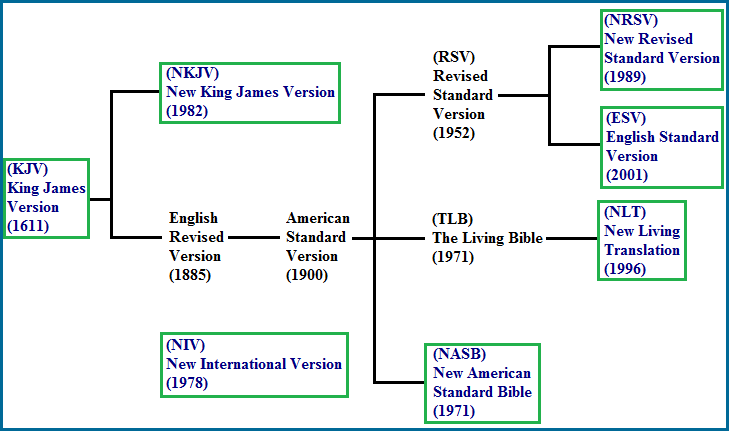Origin of Modern English Bible Translations

Most modern English bible translations are indirect revisions of the 1611 King James Version (KJV), although not all.
These indirect revisions of the original KJV include: New Revised Standard Version (NRSV), English Standard Version (ESV), New Living Translation (NLT), and New American Standard Bible (NASB).
The New King James Version (NKJV) is a direct revision of the original 1611 King James.
Bible Translation Revisions
The following illustration shows how these direct and indirect English bible translations originated:

Unlike these other translations, the New International Version (NIV) was not derived from the King James, but was instead a fresh translation of the ancient texts.
However, despite the various origins of these English bible translations, there is still very little deviation in meaning, which is largely due to the fact that all bible translations ultimately come from translating the original Hebrew and Greek texts.
Deviations in Meaning Among English Translations
Generally, when there are slight deviations in meaning between modern English bible translations, it is due to differences in the theology (religious beliefs) of the translators. For example, consider how John 3:36 is translated:
"Whoever believes in the Son has eternal life; whoever disobeys the Son will not see life, but must endure God's wrath." (NRSV)
"He who believes in the Son has everlasting life; and he who does not believe the Son shall not see life, but the wrath of God abides on him." (NKJV)
- And the NIV translates John 3:36 as:
"Whoever believes in the Son has eternal life; but whoever rejects the Son will not see life, for God's wrath remains on him." (NIV)
Therefore, regarding those who must endure God's wrath, four translations say it's those who "disobey," two translations say it's those who "disbelieve," and one translation says it's those who "reject" Jesus Christ.
Theology should never be based off one verse, so in order to know which is the best translation of this verse, other verses regarding this subject would need to be investigated.
However, deviations like John 3:36 are actually rare among various translations, causing the major difference between translations to be the actual grammar and word-order (while the meaning stays the same).
YOU MAY ALSO LIKE
-
God’s Delay Is Not God’s Denial (Ecclesiastes 3:11, Habakkuk 2:3)
Have you ever prayed for something, waited, and felt like God was silent? Have you ever believed for a breakthrough, yet faced delay after delay? Many of us... -
Biology of Cell confirms Intelligent Design: Irreducible Complexity
The complex biology of the ‘basic cell’ exhibits what has been termed ‘irreducible complexity’ by biochemist Michael Behe, due to the fact that removing even... -
What is love? It's a call to action.
What is love? It's a call to action. Guest post by Ben Byrum. -
Miraculous Physical Healing Explains Salvation: The Truth of Jesus’ Salvation
If you have stage 4 pancreatic cancer, then with current medical technology you have likely not been given any hope for getting better. Your cancer is terminal. In fact, with many diseases... -
Does Science Argue For or Against God?
Probability of the Universe Existing in Coin Flips: Flipping a coin has a 50/50 chance of heads vs tails. How many times do you think you could flip heads in a row with a 50/50 chance? -
Man Finds Single Ominous Bible Page in Wildfire Aftermath
Wildfires in Tennessee have temporarily displaced thousands of people fleeing from the destruction. Over 100 homes have been destroyed, as well as hotels and businesses. Thus far, seven people... -
How to Obey God's Will
Obeying God's will is actually more simple than it seems. The truth is that some actions are good (holy), some actions are bad (sinful), and the majority of actions are completely neutral... -
Doubting After God Answers Your Prayers
Having God answer your prayers can result in overwhelming feelings of joy, relief, and thankfulness. However, sometimes doubt of God's intervention can appear and begin to steal your confidence... -
How to Prove God Exists
For unbelievers, there are only a few ways to prove that God exists, depending on how willing they are to accept God's existence. For unbelievers who are... -
The Lie of Sanctification
Sanctification is a widely accepted belief that bridges the gap between the biblical mandate for obedience to God and the practical application of living a Christian life as...





